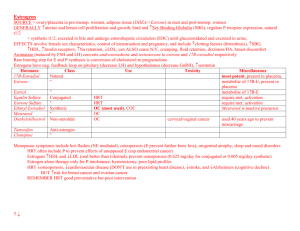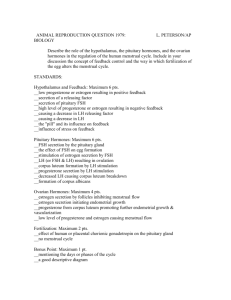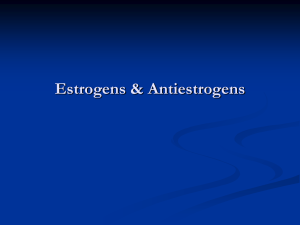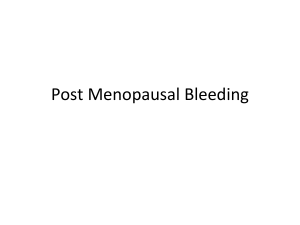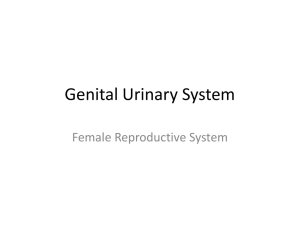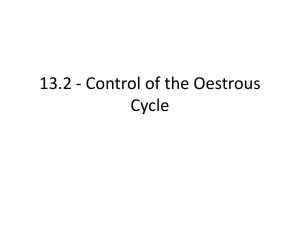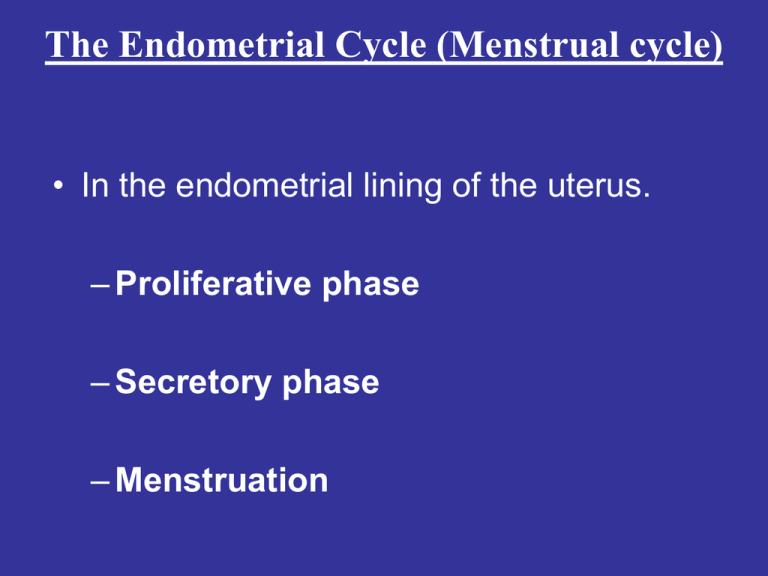
The Endometrial Cycle (Menstrual cycle)
• In the endometrial lining of the uterus.
– Proliferative phase
– Secretory phase
– Menstruation
The Endometrial Cycle (Menstrual cycle)
• Proliferative phase (11 days): Occurs before ovulation.
(but after the last cycle which desquamated the epithelium)
• Epithelial cells and stromal cells proliferate rapidly.
– Due to the high levels of _estrogen_ secreted by the
ovaries.
• The epithelial surface is re-epithelialized in 4-7 days.
• By the end of this phase the endometrium has increased
greatly in thickness (up to 3-5 mm).
• Increased number of stromal cells.
• Progressive growth of endometrial glands which produce a
stringy mucus used to guide spermatozoa.
Sherwood’s Human Physiology 20-15 5th Ed. & 20-16 6th Ed.
The Endometrial Cycle (Menstrual cycle)
• Secretory phase (12 days): Occurs after
ovulation.
• Slight proliferation of the endometrium (5-6 mm).
• Due to the corpus luteum secretion of estrogens.
• Swelling and increased secretion of the
endometrium.
• Due to the corpus luteum secretion of
progesterone.
Sherwood’s Human Physiology 20-15 5th Ed. & 20-16 6th Ed.
The Endometrial Cycle (Menstrual cycle)
• The glands increase in tortuosity.
• Excessive secretion accumulates.
• Stromal cells have large cytoplasms full of
glycogen and lipids.
• The blood supply increases & vessels increase in
tortuosity.
• The whole purpose for these endometrial changes
is to accommodate a fertilized ovum. Usually 3-4
days after ovulation.
Sherwood’s Human Physiology 20-15 5th Ed. & 20-16 6th Ed.
The Endometrial Cycle (Menstrual cycle)
• Menstrual Phase (5 days):
• If no ovum is fertilized about day 26 the corpus luteum involutes
and estrogen and progesterone levels fall.
• The decrease in estrogen and progesterone levels induce
menstruation.
– Decreased stimulation of the endometrial cells.
– Involution of endometrial cells.
• Tortuous blood vessels become vasospastic, resulting in
hemorrhage and necrosis of the tissues.
• Eventually the necrotic layers separate from the uterus until all
the superficial layer of the endometrium have desquamated.
• The mass is expelled due to uterine contractions. Within 4-7
days after menstruation starts the loss of blood stops as the
endometrium has re-epithelized.
Guyton’s Textbook of Medical Physiology 81-7
Hormonal Regulation of the Endometrial
Cycle
• Postovulatory phase
– High levels of estrogen and progesterone
secretion by the corpus luteum and secretion
of inhibin have negative feedback control (on
both anterior pituitary and hypothalamus)
over the secretion of FSH and LH.
Guyton’s Textbook of Medical Physiology 81-3
Hormonal Regulation of the Endometrial
Cycle
• Follicular growth phase
– 3 days before menstruation estrogen, progesterone,
and inhibin levels decrease, releasing their control
over the anterior pituitary and hypothalamus. FSH
and LH levels increase.
– New follicle growth induces estrogen secretion
slowly inhibiting FSH and LH production.
– (Does not explain preovulatory surge in LH and
FSH?)
Guyton’s Textbook of Medical Physiology 81-3
Guyton’s Textbook of Medical Physiology 81-3
Hormonal Regulation of the Endometrial
Cycle
• Preovulatory phase
– It is believed that the high levels of
estrogen or the beginning of progesterone
secretion is responsible for a positive
feedback resulting in a surge of LH and
FSH production.
Guyton’s Textbook of Medical Physiology 81-3
Hormonal Regulation of the Endometrial
Cycle
Sherwood’s Human Physiology 20-18 5th Ed.
& 20-19 6th Ed.
Summary
Follicular (O) & Proliferative (U) Phase
• Increasing E (from follicle) leading to a peak
before ovulation, decreasing FSH
• Ovulation
• E drop followed by LH & FSH surge and P
increase
• Luteal (O) & Secretory (U) Phase
• E & P increase, LH & FSH decrease
• Beginning of New Follicular (O) & Menstrual (U)
Phase
• E & P decrease, LH & FSH increase
•
Sherwood’s Human Physiology 20-15 5th Ed. & 20-16 6th Ed
Non-Ovarian Cycle Functions of
Estrogen & Progesterone
• Progesterone functions in breast development & and
is mainly involved in pregnancy.
• Estradiol (the principal estrogen) is involved in
development of the secondary sex characteristics of
the female.
– Increased size of the reproductive organs
– Increases osteoblast activity and therefore bone
growth
– Increases total body protein
– Slightly increase metabolic rate
– Development of a soft & smooth skin

